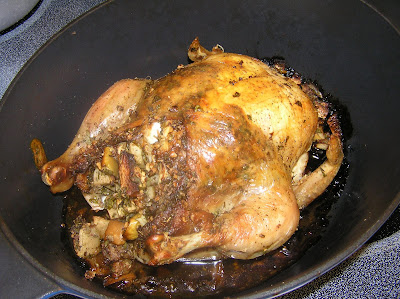This is one of my favorite dishes, and one of my most refined and researched (in terms of how much and long I experimented with ingredients and proportions) dishes. In Russia when bell pepper was available only in fall and was expensive, we usually cooked this dish for the occasions. When pepper is large and ground meat can be bought (back in home I always ground meat by myself), it becomes very easy and fast to prepare dish; it takes me usually 15-20 minutes to do so. I cook it often; it is nice as everyday meal as well.
Stuffing:
· 1 lb (500 g) ground meat (lamb, beef, pork or their mixture, coarse-ground is better than fine-ground)
· ¼ - ½ large finely chopped onion, white or yellow
· 1 tsp salt
· ½ tsp black ground pepper
· ¼ cup white round rice (medium grain)
· 1-2 tbsp parsley, dill or cilantro finely chopped (optional; I like dill and parsley for beef and cilantro or basil for lamb, but do not recommend to use cilantro and dill together)
I like it fatty (for Russians, fatty = filling) and often use 30% fat ground beef from Ralph’s. But the major trick is not in fat but in the moisture of the stuffing; it should be moist, very moist -- just add water. Rice is raw, and I usually don’t rinse or soak it; I also found out that round rice, called medium grain, works best for this dish.
I just thought that it would be interesting to try ground chicken, turkey, or mixture of chicken and meat. Then I would add in the stuffing my favorite dry poultry seasoning (salt free, from The Spice Hunter company, it contains basil, rosemary, sage, marjoram, thyme and oregano).
I need to say a word about garlic here. I like garlic, and at the same time I hate it, because it is more often overused then underused, and it can easily ruin any dish but a roasted chicken and salsa. In San Diego, there is one very expensive and fine restaurant with a chef, who loves garlic and uses it in all entries – to my taste it is disastrous, and I didn’t like all dishes I tried there. After that experience, I always think twice before using garlic, and in most cases I prefer to avoid using it as in this dish.
The other ingredients:
· 6 large meaty bell peppers (I like red (a pack from Costco), but green or orange can be used as well)
· 2 tbsp olive or any other oil
· 6 tbsp sour cream (optional)
· Parsley, dill or cilantro (optional)
· 2 large or 4 medium size carrots, cut in round (I usually do that) or squared pieces or shred (long thin pieces)
· ½ large white or yellow onion chopped or 1 white chunk of leeks cut in round pieces
· 100-500 g fresh tomatoes (optional), chopped finely or coarse large tomatoes or cherry tomatoes whole or cut in halves or quarters
· Celery (optional), cut in large pieces (I do that) or chopped
· ½ - 1 large bell pepper (optional), chopped or shred
· Mushrooms dry or fresh (optional)
In the casserole or other large enough pot to accommodate 6 peppers (or whatever number of small peppers) standing in one row on the bottom of the pot, preheat the oil. Sauté (on high/medium heat) carrots, onion (or leeks), and other optional vegetables: celery, mushrooms, pepper, tomatoes.
Add in the sauté ¼ tsp salt, black pepper and other dry or fresh herbs. I like to use tarragon (this is my second favorite herb after dill, the third will be cilantro) and oregano; if I use lamb for the stuffing, I might be in the mood for basil or rosemary and thyme.
While the vegetables sauté, I prepare pepper (wash it and remove using the paring knife the stalk and seeds, trying to leave as much pepper flesh as possible), then stuffing. I mix stuffing by a hand (left), and then use the same hand to put the stuffing in the peppers, distributing it equally among 6 peppers. The stuffing shouldn’t be pressed inside, but gently put; so there is a lot of room for juice and rice to pop up.

Place stuffed peppers in the casserole above sautéed vegetable, season generously with fresh herbs, and optionally pour a table spoon of sour cream on the top of each pepper.
Put the lead on the casserole, make the heat on medium, and cook for an hour. If in an hour the peppers are still too firm, cook another 20-30 minutes.
One pepper with vegetables makes 400-500 calories (kcal) and it supplies a day norm of vitamin A and 4-days of vitamin C!





